

'Capt. Jack' and the amazing rocket go-kart
 |
There have been a lot of weird and wild cars go down the dragstrip throughout the years. A wheelstanding tank. A jet-powered Kenworth truck. Chain-driven sidewinder dragsters and Funny Cars. But no bid for wildest drag racing machine can ante up to a rocket-powered go-kart. I’m sorry; it’s that simple. You don’t even have to have ever seen one run to know there’s no topping it.
And, of course, when you’re talking rocket go-karts, you’re talking about one man: "Capt. Jack" McClure.
When I watched McClure do his thing in my youth at Orange County Int’l Raceway, I remember thinking that he, with a name like “Capt. Jack,” must be some hotshot Air Force pilot. And he certainly looked the part in his bright silver suit, like an astronaut ready to climb into the capsule. After all, who could possibly be more trained or brave enough for such a death-defying mission?
It wasn’t until decades later that I discovered he was no military man at all but had earned his nickname for his rather less sexy occupation: fishing-boat operator.
Still, it’s a long way from slowly trawling the shores for fish to rocketing an inch and a half off the ground at 200-plus mph with a little more than a shiny suit, a helmet, and an it’d-probably-kill-him-anyway braking parachute strapped to his body, and it’s certainly a tale worth telling.
The man who would capture the imagination of race fans and the calls from strip promoters looking for the next big thing to pack butts into the seats surely never set out to be a sideshow attraction.
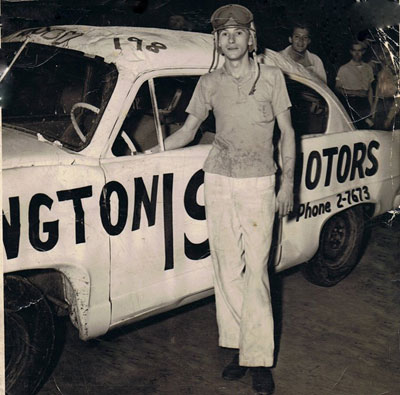
McClure cut his racing teeth on the rough-and-tumble Carolinas NASCAR circuit
|
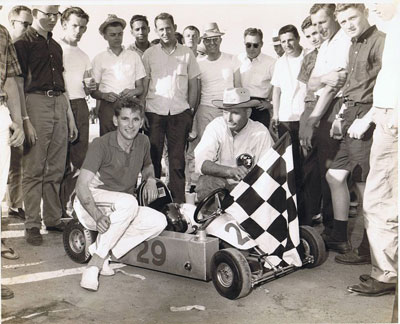
McClure was a natural in a go-kart, winning numerous events
|

McClure's twin-engine kart
|
Born and raised in the mountains of North Carolina during the Depression, McClure remembered vividly, “We didn’t have nothing. My great-grandmother was a full-blooded Cherokee Indian, and were we looked down on for that. We were lower than white trash. They'd laugh at me and my brothers in school. We'd take a biscuit and country ham for lunch while they were eating their store-bought bread and PBJ. We got bullied back then.”
McClure’s escape was his passion for cars, but of course he could barely afford one. When a local dealer of Henry Js wrecked one of his products, he offered it to McClure. “He said if I straightened it up, I could have it,” said McClure, who did just that and soon was racing the car at NASCAR events in the Carolinas in the late 1950s, running against guys who later would become NASCAR legends.
“I ran for four to five years, but there was no money in it,” he admitted. “You had to operate on what you won, so that fell to the wayside.”
In the mid-1960s, the go-kart craze started in California and moved east, and McClure just had to have one, which he quickly took to the nearest track and won the first race he entered.
“There was no money in it, but it was a lot of fun,” he recalled. “I wound up in the go-kart business, with a distributorship for Mickey Rupp's Dart kart company, selling in North Carolina, South Carolina, Georgia, and Florida. I had a team with myself and four drivers; we toured the whole Southeast, and I won just about everything you could win. We even won a hill climb up in Chimney Rock [N.C.]. We ended up with low time with our go-kart, faster than all of the cars.”
Pretty soon, one engine wasn’t enough, and McClure found new and innovative ways to mount two engines on his kart. Intrigued by the performance of his twice-motored mini mount, he took it to a local dragstrip, where it ran 100 mph. This was about 1961, as he remembers.
“I thought that was pretty good, but I forgot all about it,” he said. “About a month later, I was driving down the street in Columbia, S.C., and a car pulled up beside me. They were from the dragstrip and told me that the guy who ran the dragstrip would give me a trophy if I came back and ran at his track. I told them I had a house full of trophies. I told them that I had burned up a set of clutches the last time I ran, so if he'd give me some money, I'd run. They offered me $50. That was a pretty good hit.
“Super Stocks in the South were the cars at the time -- we didn’t have a lot of Top Fuel cars at the time – so I asked the guy at the track if I had a go-kart that would run Super Stock times and maybe even run against them, how much money would he give me. He said they'd probably give me 100, 125 bucks, so I put two more Westbends on my go-kart so that I had four motors on it. I turned 125 mph in the high 12s. I ran that thing for a year all around the Southeast at local dragstrips and got up to where they'd pay me a couple of hundred bucks to run. Gas was 29 cents a gallon, so that was good money.
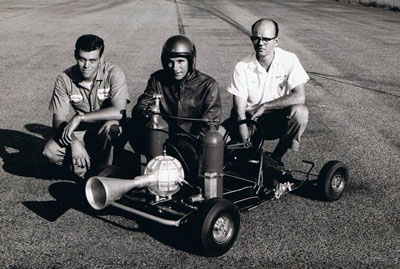
McClure, center, with the first rocket-powered go-kart ever built.
|
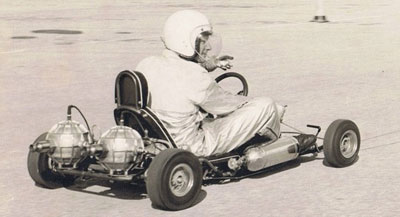
McClure quickly discovered one engine was not enough and added a second to this kart -- which featured a semi-laydown design by Mickey Rupp -- and was fast enough for promoters to match him against dragsters of the day.
|
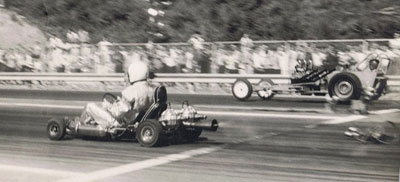 |
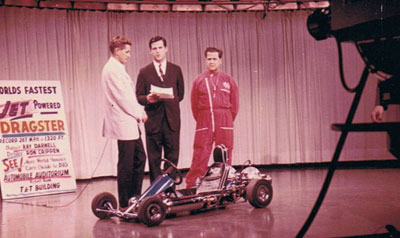
McClure's kart was featured at the 1964 World's Fair in Flushing Meadows, N.Y.
|
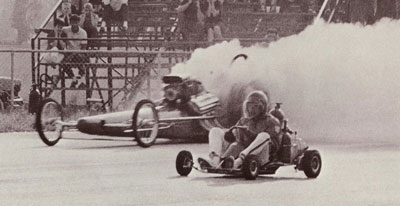
Among those McClure raced was "TV Tommy" Ivo, a match that spawned this infamous (though faked) photo of McClure out on Ivo. "I didn’t have anything to do with that," said McClure, whose broken kart was placed on the track for Ivo to race past. "The owner of Turbonique posted that picture, and it went worldwide that this go-kart was doing ol' Tommy in. I didn’t see Tommy again until I had the fast go-kart. He said 'If I had the chance to run ya again, I’d run ya over.' "
|
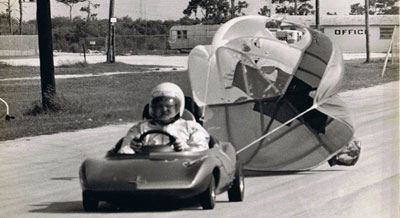
(Above) The Manta-bodied kart; (below) The Sizzler
|
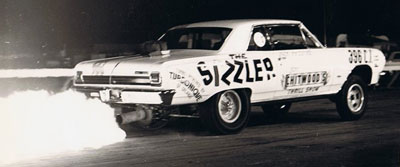 |
“Eventually, I tried six motors, but it was too heavy and wouldn’t handle and would wheelstand, but I wanted to go faster. I saw an ad in a magazine for the Turbonique turbine engine that would make 200-something horsepower.”
Based in Orlando, Fla., and run by the enterprising Gene Middlebrooks, Turbonique made a trio of go-fast accessories: a supercharger, a supercharger-driven axle, and a thrust engine.
Unlike a conventional belt-driven supercharger, the Turbonique Auxiliary Power Supercharger was like a mini rocket engine. Liquid oxygen and a rocket fuel named Thermolene were fed to the supercharger, which housed a spark plug. With the flip of a cockpit switch, the supercharger roared to life. Then there was the Turbonique Drag Axle, which became a popular go-fast addition on a lot of exhibition-type cars. Basically, it attached a Thermolene-powered rocket nozzle to the differential to spin the rear axles at superhuman speed. And, finally, there was the thrust engine, which made 300 pounds of boost for less than $200.
“Middlebrooks told me that if I wanted to go fast, instead of driving the wheels, I should use this little rocket motor they had, and that sounded right up my alley,” said McClure. “I ran down there, and he put one on my go-kart. I was booked somewhere in Georgia and didn't run fast and scared the hell out of people. I told Middlebrooks it didn’t go any faster than my wheel-driven kart, so he said we should put a second one on there, but he wanted to test it.
“He had this little shack down by a railway yard. He hooked the engine up to some lines inside the shed, and we chained the kart down outside the building. He told me to go outside and stand in the bed of the pickup truck with a fire extinguisher, and I said, 'OK,' because back then, I’d do anything. He lit that thing, but it wouldn’t shut off when he tried to shut it off. It set the grass and a whole bunch of other stuff on fire; I put the fire out and went into the shack, but he was nowhere to be seen. He finally peeks out from around a railroad car and said, 'I have a wife and two kids at home.' I said, 'And you expect me to sit on this thing and run it?' He said, 'No, it's safe now.'
"Safe" is probably a bit of an understatement in McClure’s mind.
“Basically, you had liquid fuel, compressed oxygen, and nitrogen. Nitrogen forced the fuel into the chamber, with the oxygen as an igniter,” he remembered. “The trick was once you lit that thing, you run it until you shut it down or you run out of fuel. Some guys would get to going fast and then let off on it, then they would relight it. The fuel chamber was loaded up with fuel, and when that oxygen and spark hit it, it was a bomb.”
Rupp later built McClure a laydown kart, and he took all of the running gear off the first kart and put it on the new kart and ran it until his daredevil antics caught the eye of thrill-show king Joie Chitwood, who wanted to put a Manta Jr. body on the car because Chevrolet was trying to promote the little car.
“He said if I gave them the go-kart, they'd give me a Chevelle Z-16, one of 201,” said McClure, who promptly converted the Chevelle – dubbed The Sizzler -- to accept the Turbonique axle and began spinning off performances in the mid-eights at more than 160 mph, smoking the tires throughout the course. That car ended up in a ball in Atlanta when the turbine wheel that was attached to the planetary gears to spin the axles melted at speed, locking up the rear end and sending the car into a series of barrel rolls at 162 mph. Chitwood responded by hiring McClure as one of his team’s show stunt drivers.
“I worked with Chitwood for five or six years during the season, then I'd fish in the off-season,” he said. He moved to Florida, in the Tampa/St. Petersburg region, in late 1964, a move that not only was a boon to his charter fishing business but led to a vital contact that would propel his name back into the drag racing spotlight and etch it forever into our memories.



















































